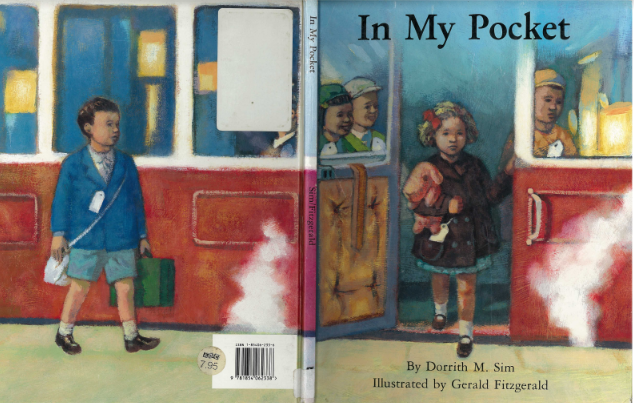https://www.amazon.com/My-Pocket-Dorrith-M-Sim/dp/0152013571?ref_=ast_author_dp
Editorial Reviews on Amazon
From School Library Journal
Grade 3-4?Based on her own experiences, Sim’s account describes in carefully worded text composed of short, simple sentences, what it was like for a seven-year-old child to leave her parents and travel from Germany to London in 1939 to live with an unfamiliar family until the war ended. The text gives little indication of the reason for the trip (“I was on a boat. A boat full of children escaping from danger.” Then, “Mutti and Vati told me the boat would take us to a new life”). She explains that in Germany she could not play with other children because she was Jewish. She receives one letter from her parents. (“I kept it with me, safe in my pocket, until there was no more war.”) Double-page, impressionist-style oil paintings show children wearing nametags clutching toy cars, stuffed animals, and small suitcases. The slightly blurred faces seem to represent Everychild. The title page and endpapers show the author’s own passport and identity document, adding a sense of reality to the narrative. Seen through adult eyes, this brief story, poignant and powerful in its very simplicity, provides a tasteful introduction to the solemn topic of the Holocaust that, despite the tender age of the central character, would be most useful as a springboard for discussion with eight- or nine-year-olds. Follow it with David Adler’s The Number on My Grandfather’s Arm (UAHC Press, 1987) and Hilde and Eli, Children of the Holocaust (Holiday, 1994).?Susan Scheps, Shaker Heights Public Library, OH
Copyright 1997 Reed Business Information, Inc.
From Booklist
Gr. 3^-6. True to a small child’s viewpoint and vocabulary, this moving autobiographical picture book personalizes the story of the Kindertransport, the organized rescue operation that took 10,000 Jewish children from Nazi Europe to Britain. The words are simple. The terse details make you know what it is like to be sent away like that. Fitzgerald’s strong double-page-spread paintings show the drama of the small girl’s leave-taking from her parents in the lowering Hamburg train station, her journey with strangers by train to Holland and by boat to Britain, and her meeting with her adoptive parents. Sepia prints of her visa and certificate of identity are quiet reminders of the refugee experience. She knows no English; all she can say is, “I have a handkerchief in my pocket.” Whenever she learns a new word, she puts it in the same sentence: “I have a house in my pocket.” The story ends with her settling in Scotland, where she keeps her parents’ letter in her pocket until there is no more war. Teachers will want to use this with Olga Drucker’s novel Kindertransport (1992), which gives the historical context. Hazel Rochman
From Kirkus Reviews
Sim’s first picture book powerfully universalizes a life- altering event of her childhood, the sending of German Jewish children away from their parents to the UK where they would be safe from the Nazis. The narrator shares her fears–most children’s fears–of having to sleep in a room full of strangers and of others getting lost at night on the way back from the bathrooms on the boat to England. She arrives in Scotland, where she must adapt to the ways of her new, English-speaking, family. The importance of small kindnesses, e.g., the man who returns the narrator’s lost stuffed dog, the generosity of the new family, loom large against the backdrop of war. Although the girl receives a letter from her natural parents, the story ends as the child puts the letter away in her pocket, for the time when there is “no more war.” It’s a devastating close, and for the picture-book audience, the book’s one shortcoming, for it leaves an explanation of the parents’ fate to those less qualified than the author, or worse, to children’s imaginations. Soft illustrations imbue the tale with the blurred edges of memory, and in the children’s faces and postures, capture the melancholy surrounding the separation. Reproductions of the author’s traveling papers, complete with photo, serve as a poignant reminder of the story’s origins in history. (Picture book. 5-8) — Copyright ©1997, Kirkus Associates, LP. All rights reserved.


